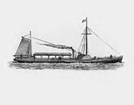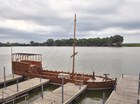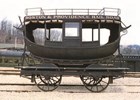The Trail of Tears involved mile after mile of hard travel through miserable conditions. Yet detachments bound for Indian Territory did more than just walk. Although time-honored methods like wagons, keelboats, flatboats, and ferries played major roles, some of the technology used to transport Cherokees on the Trail of Tears was actually quite new.
-
Trail Of Tears National Historic Trail
Article 1: Introduction: Transportation During the Cherokee Removal 1837 - 1839
The Trail of Tears involved mile after mile of hard travel through miserable conditions. Yet detachments bound for Indian Territory did more than just walk. Although time-honored methods like wagons, keelboats, flatboats, and ferries played major roles, some of the technology used to transport Cherokees on the Trail of Tears was actually quite new. Read more
-
Trail Of Tears National Historic Trail
Article 2: Steamboats: Transportation During the Cherokee Removal 1837 - 1839

From 1837 to 1839, nine different steamboats were employed to assist in the transportation of Cherokee detachments in reaching Indian Territory. These steamboats included the Knoxville, Newark, Revenue, Smelter, Little Rock, George Guess, Tecumseh, Itasca, and Victoria. Several of these steamboats were also used in the removal of the Muscogee (Creek), Chickasaw, and Seminole. Read more
-
Trail Of Tears National Historic Trail
Article 3: Keelboats: Transportation During the Cherokee Removal 1837 - 1839

Between 1837 and 1839, four Cherokee detachments utilized eight keelboats for their journeys to Indian Territory Keelboats took their name from their construction— long, narrow boats built with a keel providing stability. They typically ranged from 40 to 80 feet long and 8 to 12 feet wide, and came to a point at the bow and stern When fully loaded, the average keelboat drew 2 feet of water, which made it ideal for travel in shallow waters. Read more
-
Trail Of Tears National Historic Trail
Article 4: Flatboats: Transportation During the Cherokee Removal 1837 - 1839

Twenty-nine flatboats were used on the Hiwassee and Tennessee rivers to assist in the transportation of four Cherokee detachments to the West between 1837 and 1839. Flatboats were built commercially as early as the late 1780s and were one of the most common vernacular wooden boats used to transport people and cargo along the major southeastern rivers in the early 19th century. Read more
-
Trail Of Tears National Historic Trail
Article 5: Ferries: Transportation During the Cherokee Removal 1837 - 1839

Before bridges were common, ferries played an important role in transportation as they provided conveyance over large streams and rivers. Ferry boats were most often flatboats with modifications such as sloping ramps attached to the front and back of the boat. These allowed the ferry to pull up to the bank to unload passengers and cargo directly onto the land. Read more
-
Trail Of Tears National Historic Trail
Article 6: The Tuscumbia, Courtland & Decatur Railroad: Transportation During the Cherokee Removal 1837 - 1839

On March 7, 1837, the first of three Cherokee detachments, consisting of approximately 466 individuals, arrived in Decatur. As a crowd of spectators looked on, the following morning the Cherokee began boarding the first of two trains to take them to Tuscumbia. Unfortunately, this next leg of the journey did not go as planned. Learn more about the Tuscumbia, Courtland & Decatur Railroads that were used on the Trail of Tears. Read more
-
Trail Of Tears National Historic Trail
Article 7: Early 19th Century Roads and Turnpikes: Transportation During the Cherokee Removal 1837 - 1839

The majority of Cherokee traveled overland on foot during their forced removal to Indian Territory, with some traveling on horses and in wagons. The detachments used a network of well-known, established roads that linked major towns and settlements. Learn more about early 19th century roads and turnpikes that were used on the Trail of Tears. Read more
-
Trail Of Tears National Historic Trail
Article 8: Wagons, Carriages, and Carryalls: Transportation During the Cherokee Removal 1837 - 1839

While the majority of Cherokee walked on the Trail of Tears due to an insufficient number of horses, oxen, and wagons, animal-powered wooden vehicles were still a constant presence on the trail and played an important role in the removal by carrying goods, the elderly, and the sick. Although vehicles helped in these roles, they required regular maintenance. Poor roads and difficult terrain, worsened by inclement weather, took a toll on the vehicles. Read more
-
Trail Of Tears National Historic Trail
Article 9: The Zuraw Wagon: Transportation During the Cherokee Removal 1837 - 1839

The Zuraw Wagon, located at the Foxfire Museum & Heritage Center in Rabun County, Georgia, is not a wagon type, but the name of a specific wagon used during the Cherokee removal. It is the last remaining documented wagon with ties to the Trail of Tears. Read more
